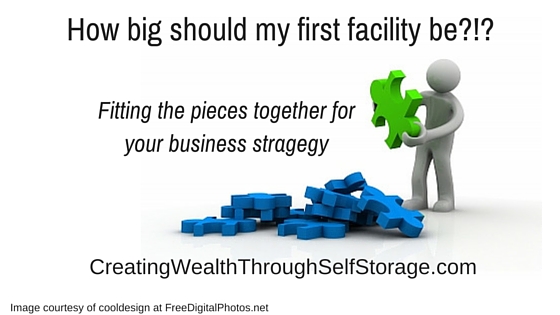“How big should my first storage facility be?
“How big a facility should I buy?”
“How big a facility should I build?”
If you’ve followed me at all, you know how I’m going to answer that question. Every single time I get asked.
“It depends.”
“It depends on what?”
“It depends on a lot of things, but primarily your business strategy.”
Your overall business strategy is the most important document or piece of information you have in the self storage business. It guides you on every decision you have to make.
- How big you should build?
- Should you have climate controlled or not?
- Should you have a manger live on site or not?
- Where should you buy or build?
- And ultimately, how you will exit the business?
Your overall business strategy answers a lot of questions. If you want more information on creating a business strategy, refer back to episodes 38, 39, & 40. This is also covered in my online courses How to Buy Your First Self Storage Facility and (coming soon) How to Build Your First Self Storage Facility, which will be available for purchase within the next couple of weeks. I have a detailed section and worksheet on designing your business strategy.
I can also run online workshops on the topic if you’re interested. Just shoot me an email through the form HERE and let me know if that’s something you would find valuable. Or you can always leave a comment below if you’d like a workshop on how to build your self storage business strategy.
But to keep it simple today, I am going to actually give you an answer.
I like simple.
Either 35,000 square feet or less, or 50,000 square feet or more.
Now for the rest of this article, everything is nothing but my opinion. I have never heard or read this anywhere, so smarter people than me may disagree.
The reason I am saying this on the size has to do with how you will manage the facility.
After running the numbers on hundreds of self storage facilities, I see that if you have a facility under 35,000 square feet, especially 20,000 or so, after the initial lease up period, these facilities can run with a part time manager, or no manager at all. I have seen many of them run well with a kiosk and a maintenance person, or someone come through two to three times a week and clean, do lock inspections, and keep the kiosk loaded and cash taken out.
You start getting over 35,000 square feet, you have a large enough facility that a full time manager is warranted.
However, from what I see, you have to be around 50,000 square feet or more, to have the income to pay a full time staff and still get the returns as an owner this business can offer.
That 35,000 to 50,000 square foot facility is a kind of no-man’s land (sorry ladies). In between land I should say. It’s large enough to warrant a full time manager, but not enough income to pay for it and give an owner a good return. Why just buy a job? If you are going to also be the manager, pay yourself for your time (bad exchange) and create the wealth you deserve for the risk as an owner.
Now that is just my opinion, and I bet there is a facility out there that proves I am wrong.
I just haven’t seen it.
Of course I haven’t been looking for it either.
But in todays market, I am actually looking for the 35,000 square feet or so facility.
As long as we can expand it.
Given the value a Seller can get for existing cash flow today, and given the fact that it is less expensive to build self storage than buy existing; expansions are a great strategy. You get immediate cash flow, albeit not great, and higher returns with the expansion.
Pay what you can for what is there, and create your returns and wealth through the expansion.
However, if every deal, or your next deal, has to be a home run, the best deal you will ever do; I doubt if self storage is the way for you to go today.
A funny thing. The best deals I have ever gotten done, I didn’t know it at the time. I was just trying to do a single or double, not a home run.
My suggestion is that if you get a single or double, on your next self storage deal, you will do fine in this business.
And for us everything goes back to the business strategy. For us a good deal, what I call a single or double, is an average return of 11% to 12% per year for the first five years, and enough created equity in the first five years to pay our investors back with a new 65% or 70% LTV re-financed loan.
It all starts and ends with the business strategy.
So the question to you is, “How big should your first storage facility be?



